The horse has always played an important role in the traditions and history of mankind and no less so in the case of China. With the exception of the dragon, which is a mythical animal, the horse is the most recurrent animal in the Chinese world, having been present from the dawn of Chinese culture, both on a mythical and symbolic level. It symbolises pure male strength (Yang) and at first was regarded as being even more potent than the dragon. Later, the horse came to be confused with the dragon and was finally substituted by the dragon as China's complex symbology emerged.
On a popular level, it is still a symbol of speed, perseverance, imagination and youthful energy. A horse at the peak of its physical and intellectual development is described as a 'thousand-league colt'. It corresponds to the element 'fire' and to the Sun. It is one of the seven treasures of Buddhism and comes seventh in the Twelve Earthly Branches. It is one of the twelve symbols of the Chinese Zodiac.
The history of the horse in China dates back over many centuries. Several sources confirm that horses were recognised in the time of the Three August Sovereigns and that Ch'in shih Huang Ti "also invented carts and ordered that oxen and horses be captured for domestication". (3) It is worth noting that in this case the horse appears in conjunction with the ox. For centuries the God of Horses was worshipped by Chinese and Barbarians alike. His image, that of an ogre with multiple arms bearing weapons and with a tiny horse at his feet, was to be found on 'lucky papers' stuck in temples and stables to ward off illness and evil spirits. To his left, also sitting above the trough which served as an alter, there was the God of the Oxen.
The Chinese dedicated themselves for centuries to improving the horse both in terms of breed and numbers. In the reign of Emperor Wu Ti (141-87BC), at a point when the Chinese had already attained a great deal of expertise in their cavalry, an expedition was led against the Hsiung-nu barbarians. (4) The Chinese managed to seize their capital and capture all the best horses which were stabled there. Once they had acquired this large group of horses, they were able to cross-breed them with higher quality horses from Western kingdoms to the satisfaction of emperor and aristocrat alike. The exquisite Eastern Han bronze statue of the 'Flying Horse' pays homage to this breed. Light-footed, well-proportioned, capable of soaring like the wind, these horses were named Tien Ma, 'Celestial Horses'.
Historically, the horse had such a profound influence on the Middle Kingdom that it might be suggested that it caused the creation of the greatest monument on earth, the Great Wall. If we consider how much protection the Great Wall gave to the eighteen provinces of ancient China which lay to the south of it, we can understand just how great was the threat from the steppes to the north. The Great Wall was erected against the apocalyptic vision of the Barbarian warriors on horseback, who came from the north. We might even go so far as to say that the Great Wall was built against the horse, since the country lived under the constant threat of invasion.
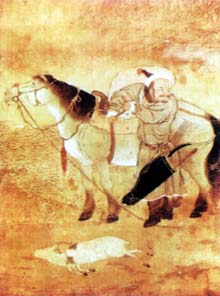

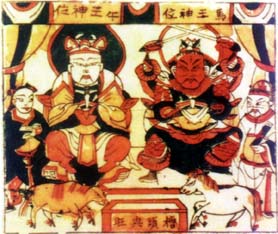
</I> and the King of Oxen <I>(Niu Wang). </I>
This is an example of the popular ) L'Imagerie Populaire Chinoise, ed. Aurora, Leningrad, reproduced from the Hermitage Museum.)
L'Imagerie Populaire Chinoise, ed. Aurora, Leningrad, reproduced from the Hermitage Museum.)
The whole system of the Chinese defense mechanism was always vulnerable to attacks by these nomadic Barbarians who were used to the harsh conditions of the steppes. Moreover, they were excellent horsemen and archers. On their agile ponies they could move in swiftly and make their attacks, confident in the knowledge that they would then be able to make off quickly to unknown destinations. Classical Chinese defense consisted of units laid out in a square in walled cities or towns which were classified into different orders, but this was an extremely vulnerable system.
Another disadvantage of Chinese defense was the fact that they used light chariots in warfare. Images of these have been transmitted to us on Bronze Age etchings. The form of the chariot reflected the religious symbolism inherent to the square (the Earth) as shown in the square box, and the circle (the Sun), the rounded cover - and all this being led by the symbol for fire, the horse. However, the disadvantage to the Chinese was that in fact the Barbarian cavalry was so mobile on horseback that these Chinese chariots were unable to keep up with them. As a result, the horse and light cavalry were to become an increasingly important strategic asset.
The attitude of the Chinese toward these Barbarian tribes is that of a feeling of superiority. It is true that they lacked a knowledge of Chinese ritual, but for all that the Chinese were more cultured, they were still at a disadvantage when it came to protecting themselves: "The strength of the Barbarians lies in their rudimentary laws and institutions. Their homes, food and clothing have for so long been so crude and barbaric that they have retained a violent savage character with the same customs, giving them a great advantage".
This situation was to present China with a dilemma for centuries: should China remain civilized and perish, or should it revert to a Barbarian state and survive. Always reluctant to relinquish any of its cultural advances, China was to reach a gradual compromise. After so many attempts by the Barbarians to penetrate the country, China allowed part of itself, the army, to become barbaric.
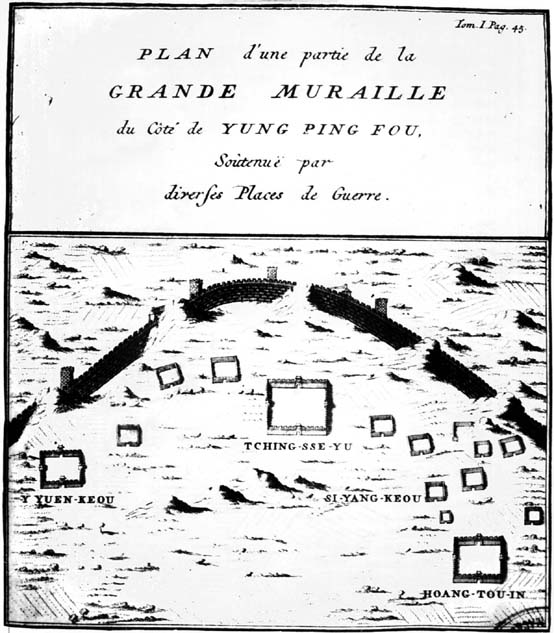 Section of the Great Wall showing the defense zone with its system of walled squares. (In J. B. Du Halde, ob. cit..)
Section of the Great Wall showing the defense zone with its system of walled squares. (In J. B. Du Halde, ob. cit..)
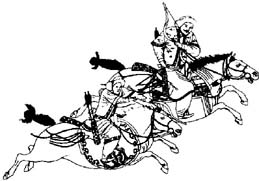 ^^CAVALRY AND EMPIRE
When the Jesuit priest, J. B. Du Halde, described the Chinese Empire many centuries later, he was to make little mention of the noble animal which had been a constant and decisive factor in the long history of the Middle Kingdom.
In his D~'escription... de l'Empire de la Chine et de la Tartarie Chinoise, he states that'in Szechuan Province there are horses which are highly sought after for being small, extremely beautiful and lively', and that in 'Yunnan there are excellent horses, mostly for riding to war, which are solid and vigorous... In the land of the Mongols, horses and wild horses are even more abundant to the west.'
Du Halde goes on to state that 'there are around seven hundred and seventy thousand troops stationed along the great wall in towns and walled sections'. The emperor also maintained 'around five hundred and sixty five thousand horses for cavalry troops and to be used for the couriers who carried his orders and those of the Tribunals to the Provinces.'(5) Marco Polo also writes that Genghis Khan organised his army into divisions, each one containing ten thousand men. He also developed a messenger system along the most important routes, whereby horses could be changed every hundred miles at staging posts guarded by troops. In his account he states that there were more than ten thousand staging posts with over three hundred thousand horses.
From the end of the Qin Dynasty (221-207BC) until the end of the Western Han Dynasty (206 BC-8AD), the horse had already begun to take on a more important role in the history of China. It was to maintain this importance until the 'golden age' of the Tang Dynasty (618-907AD). The spectacular archaeological discoveries which have been made in the People's Republic of China over the last few decades have provided new material for the experts to interpret the history of this great nation.
In 1974 the tomb of the First Emperor was discovered at Mount Li, revealing what was probably one of the greatest collections of historical material ever to be found from that period. The army of seven thousand life-sized statues with which the emperor intended to guarantee his own immortality in history and heaven was buried along with his own body so that, according to the ancient Chinese belief, they could continue to serve him in the afterlife. We also know from these archaeological finds that live horses attached to chariots were thrown into pits as part of human and animal ritual sacrifices which took place following the death of an emperor. The magnificent army discovered at Mount Li is organized in its original formation. From the extensive research which has been carried out there seems to be evidence that some of the battle chariots had reverted to their original use as observation posts and for transporting commanders from one part of the field to another. The horses unearthed during work at the site are divided into two easily distinguished groups: those used for cavalry have their tails hanging loose while those used for pulling chariots have their tails tied up or even cut off. What is most appealing, however, is the expression of their eyes reflecting an intensive level of training and discipline. Theirs is a controlled energy which could also be unleashed against the enemy whenever necessary.
The success of the Qin army in uniting feudal kingdoms in the reign of the First Emperor was largely due to the presence of cavalry regiments. The Qin Dynasty saw the introduction of not only a more manoeuvrable chariot, but also a more mobile light cavalry. Indeed, this cavalry was to prove itself a decisive force in the battles at the end of the IIIrd century. We must not forget, however, that cavalry had already been employed in the Zhou Dynasty. Other references confirming the observation that the light cavalry was quicker and more manoeuvrable than chariots were to appear in the IVth century BC. This was the case in the Northern kingdoms where cavalry had been adopted after the example of the Barbarians, along with the clothing used to dress horsemen - a practical suit of tunic and trousers.
^^CAVALRY AND EMPIRE
When the Jesuit priest, J. B. Du Halde, described the Chinese Empire many centuries later, he was to make little mention of the noble animal which had been a constant and decisive factor in the long history of the Middle Kingdom.
In his D~'escription... de l'Empire de la Chine et de la Tartarie Chinoise, he states that'in Szechuan Province there are horses which are highly sought after for being small, extremely beautiful and lively', and that in 'Yunnan there are excellent horses, mostly for riding to war, which are solid and vigorous... In the land of the Mongols, horses and wild horses are even more abundant to the west.'
Du Halde goes on to state that 'there are around seven hundred and seventy thousand troops stationed along the great wall in towns and walled sections'. The emperor also maintained 'around five hundred and sixty five thousand horses for cavalry troops and to be used for the couriers who carried his orders and those of the Tribunals to the Provinces.'(5) Marco Polo also writes that Genghis Khan organised his army into divisions, each one containing ten thousand men. He also developed a messenger system along the most important routes, whereby horses could be changed every hundred miles at staging posts guarded by troops. In his account he states that there were more than ten thousand staging posts with over three hundred thousand horses.
From the end of the Qin Dynasty (221-207BC) until the end of the Western Han Dynasty (206 BC-8AD), the horse had already begun to take on a more important role in the history of China. It was to maintain this importance until the 'golden age' of the Tang Dynasty (618-907AD). The spectacular archaeological discoveries which have been made in the People's Republic of China over the last few decades have provided new material for the experts to interpret the history of this great nation.
In 1974 the tomb of the First Emperor was discovered at Mount Li, revealing what was probably one of the greatest collections of historical material ever to be found from that period. The army of seven thousand life-sized statues with which the emperor intended to guarantee his own immortality in history and heaven was buried along with his own body so that, according to the ancient Chinese belief, they could continue to serve him in the afterlife. We also know from these archaeological finds that live horses attached to chariots were thrown into pits as part of human and animal ritual sacrifices which took place following the death of an emperor. The magnificent army discovered at Mount Li is organized in its original formation. From the extensive research which has been carried out there seems to be evidence that some of the battle chariots had reverted to their original use as observation posts and for transporting commanders from one part of the field to another. The horses unearthed during work at the site are divided into two easily distinguished groups: those used for cavalry have their tails hanging loose while those used for pulling chariots have their tails tied up or even cut off. What is most appealing, however, is the expression of their eyes reflecting an intensive level of training and discipline. Theirs is a controlled energy which could also be unleashed against the enemy whenever necessary.
The success of the Qin army in uniting feudal kingdoms in the reign of the First Emperor was largely due to the presence of cavalry regiments. The Qin Dynasty saw the introduction of not only a more manoeuvrable chariot, but also a more mobile light cavalry. Indeed, this cavalry was to prove itself a decisive force in the battles at the end of the IIIrd century. We must not forget, however, that cavalry had already been employed in the Zhou Dynasty. Other references confirming the observation that the light cavalry was quicker and more manoeuvrable than chariots were to appear in the IVth century BC. This was the case in the Northern kingdoms where cavalry had been adopted after the example of the Barbarians, along with the clothing used to dress horsemen - a practical suit of tunic and trousers.

Classical chariots, an important feature of battles in those times, were constructed out of wood with two wheels measuring around 1.80m in diameter. Once they were taken out of the plains, however, they were awkward to manoeuvre. The light war chariot was highly resistant to attack. It resembled closely the chariots made in Western Asia during the Bronze Age and was formed of a square box pulled by two horses on a flexible yoke. The seemingly distant origins of this lighter chariot are not too surprising when we consider that the horse as a domestic animal began to appear in Syria and Anatolia around the XVIIth century BC. This particular kind of chariot had in fact already been in use in China during the Shang Dynasty (c.1600-1027BC).
If we examine the development of political China, we can see that it is during periods of peacetime, or when a dynasty is being established, in other words when power is being consolidated, that cavalry is of most importance. This can be seen up until the foundation of the last era of Chinese imperial rule, as well as during periods of expansion or conquest of neighbouring regions. These situations have been repeated over the course of Chinese history.
 ^^CELESTIAL HORSES AND FLYING HORSES
However, the importance of cavalry troops really reached its peak in the period of the Western Han (206BC - 8AD). As a result, greater efforts were made to capture them and they reached prices which were to be unequalled throughout the history of China. Under the influence of one of his advisors, Emperor Wenti (179-157BC) decreed that by handing over a chariot and horse, a family could be exempted from military service.
From the outset of the Han Dynasty, there had been tremendous pressure on China's western borders from the powerful Barbarian tribes which lurked on the other side of the Great Wall. The Xiongnu were familiar neither with writing or with the concept of property. Their battle tactics were unfamiliar to the Chinese for whom retreat during an offensive was unthinkable. The Barbarians, however, used this as a simple method for avoiding excessive losses and creating confusion amongst the enemy troops.
^^CELESTIAL HORSES AND FLYING HORSES
However, the importance of cavalry troops really reached its peak in the period of the Western Han (206BC - 8AD). As a result, greater efforts were made to capture them and they reached prices which were to be unequalled throughout the history of China. Under the influence of one of his advisors, Emperor Wenti (179-157BC) decreed that by handing over a chariot and horse, a family could be exempted from military service.
From the outset of the Han Dynasty, there had been tremendous pressure on China's western borders from the powerful Barbarian tribes which lurked on the other side of the Great Wall. The Xiongnu were familiar neither with writing or with the concept of property. Their battle tactics were unfamiliar to the Chinese for whom retreat during an offensive was unthinkable. The Barbarians, however, used this as a simple method for avoiding excessive losses and creating confusion amongst the enemy troops.
 name="RETLAB2000900070004">(8)</a>
</p>
<p>
<B></B>Traditional battle tactics had depended on heavy combat between chariots, infantry charges and assaults on fortified towns so the Chinese were shocked by the strategies adopted by these nomad warriors. However, they realised that they had to include barbarian tactics in their own strategies in order to counter the threat from the North. They began to reform their own defenses and border protection by creating a new barbarian-style army. They had learned that an important aspect in war strategies was the introduction of a single commander who could take stock of a situation and make rapid decisions on the battle field. This was how, for example, General Huo Kuang was able to gain a decisive victory over the enemy. He had been particularly insistent on the need to adopt barbarian-style battle strategies and also to move further towards the West in order to reach the countries where the best horses were bred. In fact, the cavalry was to be turned into an active mass, thus requiring more and better horses, which in turn required a greater area of land turned over into pasture. The Northwestern part of China was chosen for horse breeding, not only because of its excellent natural conditions but also because of its proximity to the barbarian deserts.
</p>
<figure><img src=) Terracotta horse dressed for cavalry (2m x 1.72m) from the First Emperor's tomb at Mount Li.
Bronze horses in a set of four to be harnessed to the carriage of one of the emperor's favourite concubines from the First Emperor's tomb at Mount Li.
Terracotta horse dressed for cavalry (2m x 1.72m) from the First Emperor's tomb at Mount Li.
Bronze horses in a set of four to be harnessed to the carriage of one of the emperor's favourite concubines from the First Emperor's tomb at Mount Li.
From the beginning of the Han Dynasty there are references to crossbreeding Bactrian and Arab horses, a fact which can be confirmed by the greater corpulence and different colouring of horses in the statues dating from that period.
Prior to the discoveries made at Mount Li, archaeological teams had already discovered another army in a tomb in the ancient Han capital Hsien-yang, Shensi Province, dating from the Western Han period. More than two and a half thousand statues made of painted terracotta were ranged in perfect battle formation. There is abundant proof in this collection of the presence of a strong cavalry force covering the infantry and providing a link between different bodies of soldiers. In addition to this, there are four companies of cavalry reserves who would have been used for varied purposes including surprise charges and rapid surrounding of enemy troops. This strategy was the basis for the Han victories over the nomad warriors and later the Xiongnu tribes. According to the archaeologists, the model army seems to have been a replica of the army which was led by Zhou Yufu against invading armies during the reign of the fourth Han Emperor. (9)
This emperor was noted not only for his generous stocking of the imperial stud farms so that five hundred thousand horses were available for the sole use of the army, but also for the cunning strategies adopted by his general. The latter decided that it was more important to strengthen the force of the light cavalry and to coordinate the movements of the entire army through them.
For this reason Emperor Wu, the fifth emperor to reign during the Han Dynasty, made the move to go on the offensive rather than just use his forces to defend the country. The Barbarians had made repeated attempts to penetrate China from the northern borders from the second century BC and although there had been moves to reach a settlement through the marriage of a Chinese princess to the head of the Xiongnu, this did little to appease them. In 149BC the Barbarians had attacked Shensi and razed the imperial stud farms and in the following year they had gone as far as where Peking is now situated.
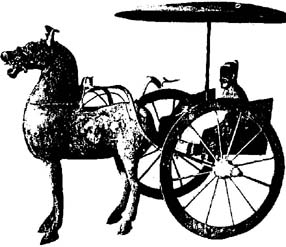 Bronze war chariot with charioteer, dating from the Eastern Han Dynasty, part of a small army discovered in 1969 in Leitai, Gaansu Province. The increase in the use of chariots and particularly light cavalry in warfare dated from the Western Han Dynasty.
Bronze war chariot with charioteer, dating from the Eastern Han Dynasty, part of a small army discovered in 1969 in Leitai, Gaansu Province. The increase in the use of chariots and particularly light cavalry in warfare dated from the Western Han Dynasty.
Emperor Wen's desire to extinguish the threat from the Xiongnu and gain access to better quality horses was to lead to the famous mission made by Chang Ch'ien, who set out in search of the Yueh-chih, sworn enemies of the Xiongnu. However, he was captured by the nomads and held prisoner for ten years after which time he managed to escape and arrive at Ferghana. Here he was provided with guides who led him to Transoxiana and from there he travelled to Bactriana until he reached the south of Amu-Darya "where he found the Yueh-chih, who had adopted a settled life and were known to the Greeks by the name of Indo-Scythians".(10)
It seems Chang Ch'ien fell once more into the hands of the Xiongnu on his return to China and only managed to return to his homeland twenty years after having left it. Records of his travels leave us with descriptions of a variety of kingdoms and cultures. Ferghana was an agrarian culture, rich in rice and with horses who were reputed to sweat blood. He had encountered a fermented drink made from a fruit as yet unknown in China: the grape. The inhabitants of Transoxiana were nomads, famed for their skills with the bow and arrow. Bactriana had good countryside and cities, similar to Ferghana. But most importantly, Chang Ch'ien was able to bring back magnificent horses. (11)
Chang Ch'ien's journey was the first contact which had been made with the people on the far side of the barbarian belt fencing-in northern China. For the first time they were exposed to central Asian cultures which in turn had been exposed to Grecian civilisation. In fact, Alexander the Great (356-323BC) had gone as far as eastern Persia and there had no doubt been some cross-breeding at that point.
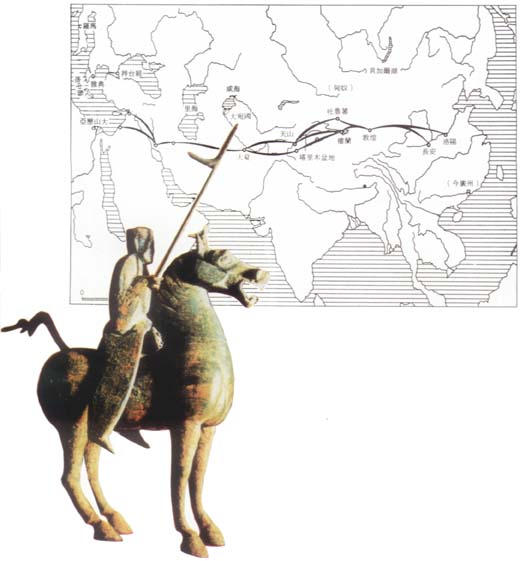 Halberdier and horse made of bronze, dating from the Eastern Han Dynasty. This is an interesting piece, as it shows a weapon which was widely used in early cavalry warfare but which fell into disuse as light cavalry became more widespread. The rider inclines forward with his lance as the horse's head is drawn back, giving the impression that together they are about to charge into battle against an imaginary enemy.
Halberdier and horse made of bronze, dating from the Eastern Han Dynasty. This is an interesting piece, as it shows a weapon which was widely used in early cavalry warfare but which fell into disuse as light cavalry became more widespread. The rider inclines forward with his lance as the horse's head is drawn back, giving the impression that together they are about to charge into battle against an imaginary enemy.
Little by little, products from trading with other countries began to infiltrate into China: rugs, precious stones, the donkey which was introduced by the Xiongnu, the grape and animals which had been hitherto unknown such as certain breeds of horses.
Thus we can say that Chang Ch'ien's journey past the frontiers of the Middle Kingdom was the first step in linking China to the famous silk route. In fact, it might be more appropriate to describe this route as the 'horse route', since it was really to acquire horses that the Chinese Court bartered the Xiongnu with silks and iron objects. (12)
Consequently it is hardly a coincidence that the statues unearthed by archaeologists dating from this period often portray horses and their riders. This a reflection of the rise of the light cavalry in military strategies. The colouring of these horses reflects a purer breed of animal, surely the outcome of successive crossbreeding in the imperial stud farms. No longer do we find the squat breed of horse of the kind found in the imperial tomb at Mount Li. The newer breed of horse was more powerful, and also more graceful. They were certainly swifter and well deserved their nickname of 'flying horses', examples of which have been found in Western Han Dynasty tombs in Kansu Province.

CULTURE IN THE SHADOW OF PEACE
War strategies during the Eastern Han Dynasty (25-220AD), and over the next four centuries leading up to the Tang Dynasty, focussed on perfecting the breeding of horses and improving the cavalry. During this period the capital was located in Loyang. From the reign of Chang Ch'ie, China began to stir from her isolationist torpor and to diversify her alliances in order to neutralize threats from neighbouring kingdoms. There was also increasing interest in acquiring stronger trade links and access to basic goods, such as the horse. Ancient China was beginning to look more and more to the West.
China had long been steeped in tradition and was highly conscious of her own cultural superiority, being reinforced by intellectuals, such as poets and artists who left a wealth of works in their wake. China was feeling an ever greater cultural pressure for peace. Or for war... an opportunity for her to show her superior power. There was no shortage of human fodder for the armies and China was soon to close in on those neighbours she knew of. The first census taken during the reign of the First Emperor set the population at over fifty seven million, a larger number than was present throughout the Roman Empire at the peak of its power. Political unity and horses were the most valuable assets at this stage.
The dilemma centred round whether to turn wild and survive, or to remain civilised and perish. The Latin phrase Si vis pacem para bellum ('if you wish for peace, prepare for war') finally took centre stage. The early years of the Tang Dynasty are sufficient proof of this: cultural life was to flourish under the cover of preparation for war.
Contacts with the western kingdoms of Ferghana, Transoxiana, Bactriana and then with Persia and the Arabs, and the increased contacts with Central Asia and, to the South, Tibet were directly reflected in improvements to the Chinese horse through cross breeding. From 558 to 578, towards the end of the Northern and Southern Dynasties, China's fame also attracted several embassies from Persia and Central Asia to Ch'ang-an.
In the first five years of the Tang Dynasty, efforts were made to eliminate all enemy forces including the Tangut(13) and especially the new threat posed by the Turkish invaders. After various incursions on the western borders of the country the Turks finally reached out towards Ch'ang-an but they were beaten back as far as Mongolia. By the year 640 the Tang had gained control of the kingdom of Kaoch'ang, famed for its excellent breeds of horses.
The law of supply and demand meant that during that period it was possible to buy a horse for forty pieces of silk. The times when horses could be bought for a hundred pieces of gold seemed long since gone. There are many conflicting references to the number of horses, as the only reliable source consists of accounts of battles and military clashes.
There is mention of the fact that the acquisition of five thousand horses resulted in twenty thousand horses being bred, and that Emperor Chung Hsian had around forty thousand chargers, most of which had come from Central Asia. In 725, when the Tang Dynasty was at its peak, numbers indicate that there were around four hundred and twenty thousand horses available. This quantity had been guaranteed by the fact that a decree in 705 had implied the recovery of pasture land for imperial use.
The good years were not to last long, however, as the peace which China was enjoying eventually led to decline in the state. Having suffered from the prolonged effects of constant warring between feudal states and kingdoms all seeking power through the control of the country, and beginning to feel that having quelled the threats from bordering regions, China's creativity was to be swamped by decadence.
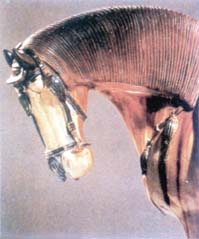
This beautifully defined head reflects the favoured position enjoyed by horses during the Tang Dynasty. As a mark of high class, we can see in this example the care taken in the richly decorated harness and delicately groomed mane.
For centuries, China's defence had depended on a complex system of inter-connected strategic positions, most obviously in the region of the Great Wall. The Imperial Guard were the central corps of the army, supported by the regiments billeted in fortified cities and the units posted to the Great Wall. Units communicated by means of a system of lights and smoke signals. There were also special troops responsible for protecting pastures and the herds of horses. Soldier-farmers received land for growing crops and for purposes of defence, while the canal soldiers were responsible for protecting the imperial waterways. During the Han and Qin Dynasties there was conscription and men between the ages of twenty three and thirty were required to serve one year in the Imperial Guard and a further year in their home regions.
The whole system was gradually dismantled and a professional army established. Emperor Hsuan-tsung ascended the throne in 712 and with a view to making the army more efficient decreed in 723 that there should be a permanent Imperial Guard. In order to obtain one hundred and twenty thousand men to serve in this guard, it was necessary to abolish many taxes and certain kinds of punishments.
The hard-won peace gained by defeating the Eastern Turks in 630, the Western Turks in 657, the Janpanese in 663 and Korea in 666-668 boosted the confidence of the empire to such an extent that in 737 the emperor was led to soften the regime for recruiting soldiers:"As there is no reason to worry in the Empire, it is worth giving some leeway to the men. As from now, there will be troops composed only of permanent soldiers responsible for guaranteeing the safety of this country..."(14)
The fact that military service was no longer compulsory meant that in 745 Minister Lei Liu fu drew up a decree, which meant that conscription would virtually be a thing of the past. There was no longer any need for the border troops to be out in full force.
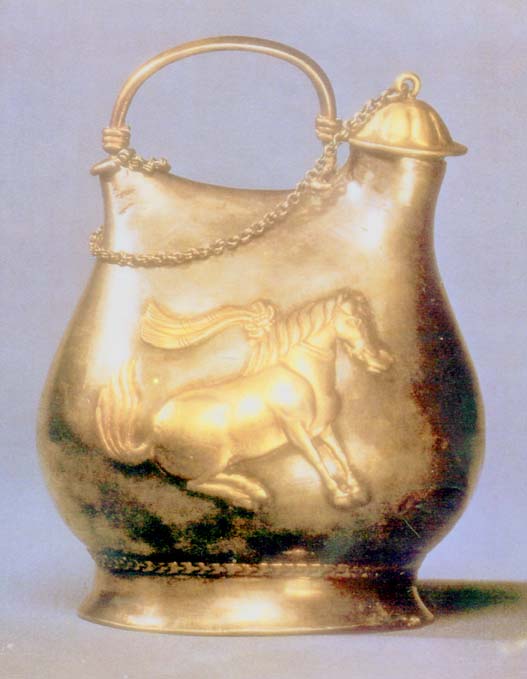
Silver traveller's flask plated with gold (18.5cm high) dating from the Tang Dynasty (VIIth or VIIIth century) discovered in Xian. The figure in relief is a "dancing" horse from Emperor Xuangzong's famous school (reproduced from Tr~'esors d'Art de la Chine).
Without the Tang having to pay any particular attention to it, the old dilemma reappeared - danger does not always lurk on the outside of the empire.

THE DANCING HORSES
Up to this point, the generations of new breeds of horses had been destined for military use in the cavalry regiments, for pulling carriages, for transportation, mail and other forms of communication. The refinements of the Tang era were also to be reflected in the horse and the ways in which it was used.
The horse in the Tang Dynasty was a highly-bred animal which scarcely resembled the ponies of the reign of the First Emperor. This development can be proved through archaeological finds dating from the Western Han to the Tang Dynasties. For example, the statues of horses found in the First Emperor's tomb at Mount Li are quite short, measuring around 1.70m high and 2m long, thus reflecting their close relation to the ponies brought by the nomads from the Northwest and the Mongolian steppes.
These statues seem to correspond to the depiction of horses found on prints, drawings, paintings and other statues dating from the same period. As we can see, at this time there was a marked difference between the height in relation to the length of the horse. After this stage, the proportions of the horse gradually changed until the height equalled the length of the bod, resembling the horses which appear in the paintings, and bronze and clay statues produced by Tang artists.
A variety of factors, however, may have affected the way in which the horse was portrayed, meaning that its representation would diverge somewhat from reality. Chinese painting and calligraphy developed in such a way as to emphasise ideas rather than form. Pervading the entire work of art, there is, as a general rule, an impression of qi, the essential spirit achieved when the artist is completely in harmony with his subject.
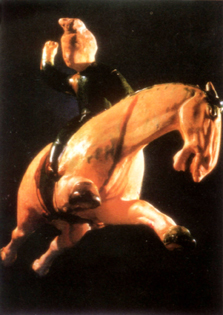
The game of polo originated in Persia but quickly became a favourite pastime of Tang Dynasty aristocrats. This realistic model captures the movement and speed of the game. The horse strains to stretch his legs out as far as possible, his head to one side, to give the player maximum freedom to hit the ball. In turn, the player's body is taut, his knees gripping the horse as his head is raised in anticipation of hitting the ball. The intense yet impassive expression on his face produces an exquisite balance.
As a result, the balance between height and length may have been created from a desire to attain harmony between the reality and spirit of the horse. Nevertheless, it is still true that the aim of horse-breeders all over the world is to obtain this perfect complement of measurements. The Tang Dynasty was, however, a period of artistic realism and there can be no doubt that craftsmen of the time were highly attentive to the details of the animals they modelled.
What could possibly be said is that the horses we see modelled in clay and bronze statues were not copied from the general kind of horse available, but rather from the highly-bred descendants of horses from Ferghana and Persia. These were owned by the emperor, the Court, the noble classes, eunuchs and concubines as a mark of their social standing. This can be confirmed by the exquisite trappings which adorn them.
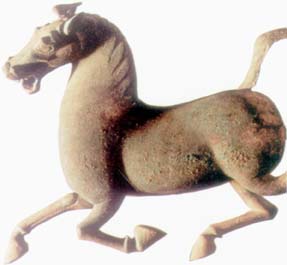
Fei Ma, the flying horse which has been adopted as a motif by the Chinese tourist department. This example, made of bronze and dating from the Eastern Han Dynasty, was found in Leitai, Wuwai in 1969. The grace and movement of the horse is captured in the delicate turn of the head and the lightness of the hoofs.
Peacetime was to focus attention on the horse in new ways. The horse was to become a symbol of wealth and distinction, employed in hunts and games of polo which were the new occupations of the wealthy classes. Riding schools were also established to train horses in the patient discipline of dressage. By 667 an imperial edict had reserved the riding of horses for the ruling classes only.
Horses were imported in large numbers from the Middle East and Transoxiana to be used for cross-breeding with the horses in the imperial stables. The magnificent horses bred from horses from Ferghana and Kokand were very highly valued. These latter were named 'celestial' and of them all, the white ones were the most most sought-after. Horses of this breed were frequently used as subjects for paintings by famous artists.
The artist Han Gan (c. 720-780) gained a reputation by painting the horses of Emperor Hsuan-tsung and his favourite concubine Yang Yu-huan (Yang Kuei-fei), in particular the one called Zhaobaiye (night-shining whiteness).
In the belief that polo was excellent training for his troops, Emperor Hsuan-tsung encouraged its practise by means of an imperial decree issued in 747. The game was already popular amongst the ruling classes after Emperor Tai-tsung had seen a display by polo teams who came from Tufan. Archaeological excavations have revealed polo fields within the grounds of palaces and summer retreats.
Polo was played in teams of twenty players on horseback. (15) It is still a popular game in Mongolia, the country from which it was imported during the Tang Dynasty. Originally, the game is known to have come from Central Asia or Persia.
Equestrian arts reached their peak under the reign of Emperor Hsuan-tsung who was an enthusiastic supporter of dressage. His 'dancing horses' were to become a legend over the following centuries. In the Official History of the Tang (begun in 941) there are references to the foreign 'dancing horses' in the emperor's dressage schools. Two rows of elegant horses would dance to the sound of an orchestra directed by two women. The most spectacular moment would come when the tune Qingbei qu ("Song of the Up-turned Cup") was played.
One of the most beautiful pieces to have been discovered in recent years is a silver and gold traveller's flask dating from the Tang Dynasty. Chinese archaeologists called the horse which is depicted in relief on the surface of the flask a 'dancing horse' as it is certainly a representation of one of the famous horses from the dressage school. The horse is seated with a glass in its mouth. The ears are pinned back, which seems to indicate a pause in the music, or that the horse is waiting for a musical signal. Surely this elegant, graceful horse is the symbol of the 'golden age' of peace, which was brought in by the dazzling Tang era.
Horses were also used to entertain state guests. A passage from the Jinglung wenquanji ("Annals of the Pavillion of Jinglung Era Literature") give us a description of a banquet given in honour of a Tibetan embassy. During the dinner, trained horses were exhibited: "They started to dance in a row to the first chords of the music.... At each refrain the musicians allowed them to drink. Then, taking the wine glasses between their teeth they sat down and then got up again to the delight of the Tibetans". (16)
When, under the pretext of the excessive nepotism practised by the emperor's favourite concubine Yang Yu-huan, General An Lu-sha headed a military uprising which ended in the emperor fleeing the capital and the dramatic death of the concubine, the 'dancing horses' were split up. Some of them were used for troops stationed on the border, a mistaken ploy, for as the shawns played they started to dance in the middle of the charge.
One of the most beautiful pieces to have been discovered in recent years is a silver and gold traveller's flask dating from the Tang Dynasty. Chinese archaeologists called the horse which is depicted in relief on the surface of the flask a 'dancing horse' as it is certainly a representation of one of the famous horses from the dressage school. The horse is seated with a glass in its mouth. The ears are pinned back, which seems to indicate a pause in the music, or that the horse is waiting for a musical signal. Surely this elegant, graceful horse is the symbol of the 'golden age' of peace, which was brought in by the dazzling Tang era.
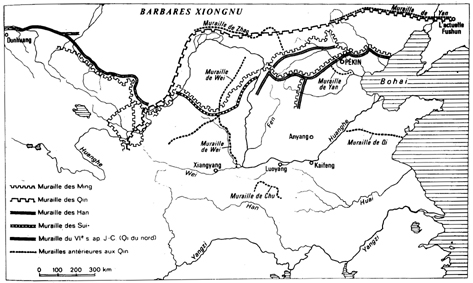
Map of China showing the development of the Great Wall (rep. Les Chinois, Claude Larra, Paris, Editions Lidis).
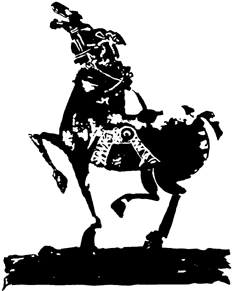
NOTES
(1)The horse is one of the Seven Treasures (in Sankrit Sapta Ratna) or symbols of a Chakravarti (Sovereign of the Universe), the other six being the Golden Wheel, the Miraculous Pearl, the Twins, the Elephants, the Divine Guardians of the Treasury and the Military Governors. (From Outlines of Chinese Symbolism and Art Motives, C. S. Williams, Ed. Kelly and Walsh, Taiwan.)
(2)Wang Chuanshan, Du Tongjianlun quoted by E. Balzas "La Bureaucratie Celeste" in Les Chinois-Esprit et Comportement des Chinois comme ils se r~'ev~`elent par leurs livres et dans la vie, des origines ~`a la fin de la dynastie Ming, 1644, Claude Larra, Ed. Lidis, Paris.
(3) Description G~'eographique, Historique, Chronologique, Politique et Physique de l'Empire de la Chine et de la Tartarie Chinoise, J. B. Du Halde, SJ, ed. Henri Scheurleer, The Hague, 1736.
(4) Xiongnu is the Chinese name for the Huns.
(5) J. B. Du Halde, SJ, ob. cit.
(6)Enciclop~'edia Luso-Brasileira de Cultura, Editorial Verbo, Lisbon.
(7)The Manchus were in actual fact Jurchen, descendents of the Tungu tribes which founded the Chin Empire in the XIIth century (1115-1234) in the North/ Northeast of China. They made their capital to the Northeast of where Harbin is now situated, later transferring it to Peking in 1151 and then to Kaifeng. The Manchus took over China as the ruling race, imposing certain laws and customs on the indigenous Chinese peoples. They made them change their style of dressing and the way in which they wore their hair, forcing them from 1645 onwards to wear queues, under pain of death. This move provoked rebellions which were brutally stamped out. The use of the queue had also been imposed by the Manchus on the tribes in the Steppes. The Mongols wore various kinds of queue and in the Vth century the Tabgatch were described as 'corded heads' by the Chinese. ('Taken from A History of Chinese Civilization by Jacques Gernet, ed. Cambridge University Press.)
(8) ob. cit., Les Chinois, Claude Larre.
(9) ob. cit., Tr~'esors d'Art de la Chine.
(10) ob. cit., A History of Chinese Civilization.
(11) "When Chang Ch'ien returned from his visit to the Yueh-chih, he told the Son of Heaven of the customs and positions of all the countries in the Tacia basin. He explained that the Dayuan was in western China, at a distance of ten thousand li and that the people spent their lives engaged in farming and breeding excellent horses. There are walled cities and huge buildings..."(taken from L'Histoire Dynastique des Han Ant~'erieures, quoted in Claude Larre, ob. cit).
The Tarim basin constituted the large space between China and India which at that time was regarded as strategic to the Chinese Empire in its future expansion towards the South of the country and in the development of trade links with the West.
For more information about Chang Ch'ien's journey, please see La Civilisation de la Chine Classique by Vadime and Danielle Elisseff, ed. Arthaud, Paris, 1987.
(12) ob. cit., A History of Chinese Civilisation, Jacques Gernet.
(13) Or the Tanguts, the Ch'iang to the Chinese.
(14) ob. cit., Tr~'esors de L'Art de la Chine.
(15) idem.
(16) idem.